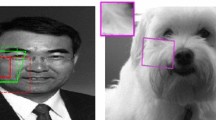Abstract
The problem of recognizing objects subject to affine transformation in images is examined from a physical perspective using the theory of statistical estimation. Focusing first on objects that occlude zero-mean scenes with additive noise, we derive the Cramer-Rao lower bound on the mean-square error in an estimate of the six-dimensional parameter vector that describes an object subject to affine transformation and so generalize the bound on one-dimensional position error previously obtained in radar and sonar pattern recognition. We then derive two useful descriptors from the object's Fisher information that are independent of noise level. The first is a generalized coherence scale that has great practical value because it corresponds to the width of the object's autocorrelation peak under affine transformation and so provides a physical measure of the extent to which an object can be resolved under affine parameterization. The second is a scalar measure of an object's complexity that is invariant under affine transformation and can be used to quantitatively describe the ambiguity level of a general 6-dimensional affine recognition problem. This measure of complexity has a strong inverse relationship to the level of recognition ambiguity. We then develop a method for recognizing objects subject to affine transformation imaged in thousands of complex real-world scenes. Our method exploits the resolution gain made available by the brightness contrast between the object perimeter and the scene it partially occludes. The level of recognition ambiguity is shown to decrease exponentially with increasing object and scene complexity. Ambiguity is then avoided by conditioning the permissible range of template complexity above a priori thresholds. Our method is statistically optimal for recognizing objects that occlude scenes with zero-mean background.
Similar content being viewed by others
References
Ballard, D.H. and Brown, C.M. 1982. Computer Vision. Prentice-Hall: Englewood Cliffs, NJ.
Betke, M. and Gurvits, L. 1997. Mobile robot localization using landmarks. IEEE Trans. Robotics and Automation, 13:251-263.
Betke, M. and Makris, N.C. 1995. Fast object recognition in noisy images using simulated annealing. In Proceedings of the Fifth International Conference on Computer Vision, Cambridge, MA, June 1995. IEEE Computer Society: Los Alamitos, CA, pp. 523-530.
Betke, M. and Makris, N.C. 1997. Information-conserving object recognition. Technical Report CAR-TR-858, CS-TR-3799, University of Maryland.
Betke, M. and Makris, N.C. 1998. Information-conserving object recognition. In Proceedings of the Sixth International Conference on Computer Vision, Mumbai, India, January 1998. IEEE Computer Society: Los Alamitos, CA, pp. 145-152.
Cernuschi-Frias, B., Cooper, D.B., Hung, Y.-P., and Belhumeur, P.N. 1989. Toward a model-based Bayesian theory for estimating and recognizing parameterized 3-D objects using two or more images taken from different positions. IEEE Trans. on Pattern Analysis and Machine Intelligence, 11:540-564.
Chin, R.T. and Dyer, C.R. 1986. Model-based recognition in robot vision. Computing Surveys, 18(1):67-108.
Difranco, J.V. and Rubin, W.L. 1968. Radar Detection. Prentice-Hall: Englewood Cliffs, NJ.
Downie, J.D. and Walkup, J.F. 1994. Optimal correlation filters for images with signal-dependent noise. Journal of the Optical Society of America A 11:1599-1609.
Friedland, N.S. and Rosenfeld, A. 1991. Lobed object delineation using a multipolar representation. Technical Report 2779, University of Maryland.
Gabor, D. 1946. Theory of communication. J. Inst. Electri. Eng., 93:429-457.
Goodman, J.W. 1965. Some effects of target induced scintillation on optical radar performance. In Proceedings of the IEEE, 53:1688-1700.
Goodman, J.W. 1985. Statistical Optics. Wiley: New York.
Horn, B.K.P. 1986. Robot Vision. MIT Press: Cambridge, MA.
Jain, R., Kasturi, R., and Schunk, B. 1995. Machine Vision. McGraw Hill: New York.
Kashioka, S., Ejiri, M., and Sakamoto, Y. 1976. A transistor wire-bonding system utilizing multiple local pattern matching techniques. IEEE Transactions on Systems, Man and Cybernetics, 6(8):562-569.
Kay, S.M. 1993. Statistical Signal Processing. Prentice Hall: Englewood Cliffs.
Kelley, R.B., Martins, H.A.S., Birk, J.R., and Dessimoz, J.-D. 1983. Three vision algorithms for acquiring workpieces from bins. Proceedings of the IEEE, 71(7):803-820.
Kirkpatrick, S., Gelatt, C.D., and Vecchi, M.P. 1983. Optimization by simulated annealing. Science, 220:671-680.
Levanon, N. 1988. Radar Principles. John Wiley and Sons: New York.
Makris, N.C. 1995. A foundation for logarithmic measures of fluctuating intensity in pattern recognition. Optics Letters,20:2012-2014.
Makris, N.C. 1996. The effect of saturated transmission scintillation on ocean acoustic intensity measurements. Journal of the Acoustical Society of America, 100(2):769-783.
Makris, N.C., Avelino, L.Z., and Menis, R. 1995. Deterministic reverberation from ocean ridges. Journal of the Acoustical Society of America, 97(6):3546-3574.
Metropolis, N., Rosenbluth, A.W., Rosenbluth, M.N., Teller, A.H., and Teller, E. 1953. Equations of state calculations by fast computing machines. 1953. J. Chem. Physics, C-21:734-738.
Poynton, C. 1993. “Gamma” and its disguises: The nonlinear mappings of intensity in perception, CRTs, film and video. J. SMPTE, 102:1099-1108.
Rao, C.R. 1973. Linear Statistical Inference and its Applications, 2nd ed. Wiley and Sons: New York.
Rosenfeld, A. and Kak, A.C. 1982. Digital Picture Processing, 2nd ed. Academic Press: New York, Vol. 2.
Strang, G. 1976. Linear Algebra and its Applications. Academic Press: San Diego.
Strenski, P.N. and Kirkpatrick, S. 1991. Analysis of finite length annealing schedules. Algorithmica, 6:346-366.
Szu, H. and Hartley, R. 1987. Fast simulated annealing. Physics Letters A, 122:157-162.
Trucco, E. and Verri, A. 1998. Introductory Techniques for 3-D Computer Vision. Prentice Hall: New York.
Umbaugh, S. 1998. Computer Vision and Image Processing. Prentice Hall: Englewood Cliffs, NJ.
Van, H.L. Trees. 1968. Detection, Estimation, and Modulation Theory, Part I. Wiley: New York.
Yoshimura, S. and Kanade, T. 1994. Fast template matching based on the normalized correlation by using multiresolution eigenimages. In Proceedings of the International Conference on Intelligent Robots and Systems, Munich, Germany, September 1994.
Zadeh, L.A. and Ragazzini, J.R. 1952. Optimum filters for the detection of signals in noise. In Proc. IRE, 40:1123-1131.
Author information
Authors and Affiliations
Rights and permissions
About this article
Cite this article
Betke, M., Makris, N.C. Recognition, Resolution, and Complexity of Objects Subject to Affine Transformations. International Journal of Computer Vision 44, 5–40 (2001). https://doi.org/10.1023/A:1011168302294
Issue Date:
DOI: https://doi.org/10.1023/A:1011168302294




